The best cameras for vlogging should offer you impeccable 4K video quality in a small, portable body that also accommodates accessories such as microphones or external monitors.
If you’re looking for a vlogging camera, or a camera for content creation, then you’ll likely be after something which can not only produce excellent footage, but is also easy to use.
The majority of the cameras in our round-up of the best cameras for vlogging feature tiltable or articulating screens that allow you to point the camera at yourself and still compose your shot. That’s super-useful if you don’t happen to have your own camera operator on hand.
What are some of the other features you might find handy? These are some of our favourites.
What features to look for in a vlogging camera
When choosing the best camera for vlogging, there are a handful of essential features you’re going to want to look for in its specifications.
For starters, we expect a vlogging camera to be able to shoot 4K video these days. Ideally you want 4K video at 60fps, but 30fps will also suffice. You’ll also want a range of frame rates for Full HD video recording.
A mic input is also an essential feature these days to enable better quality sound to be recorded via an external mic. A headphone port is also a nice-to-have, but maybe not an essential feature.
In addition to the mic input you’ll want a hotshoe for mounting microphones such as the Rode VideoMic Pro.
Also look for a vlogging camera with a flip-out screen, or at least a tilting touchscreen LCD. On vlogging cameras like the Nikon Z50, for instance, the screen can be tilted up or down for viewing from above or below. Or it can tilt down through 180-degrees for viewing from in front of the camera when filming yourself.
Another essential feature is the ability to connect your camera to your smartphone or tablet via Wi-Fi for quick sharing – all of the cameras here have that function.
In addition to tradition interchangeable lens cameras, we’ve also taken a look at the best action camera on the market, for those of you who like to create adventurous vlogs.
The best cameras for vlogging you can buy today
Read on to find out our picks for the best vlogging cameras you can buy today. These picks are based on our tests using these cameras out in the field. For a deeper dive into the many different camera types and features available, check out our range of camera buying guides.
Panasonic Lumix G100
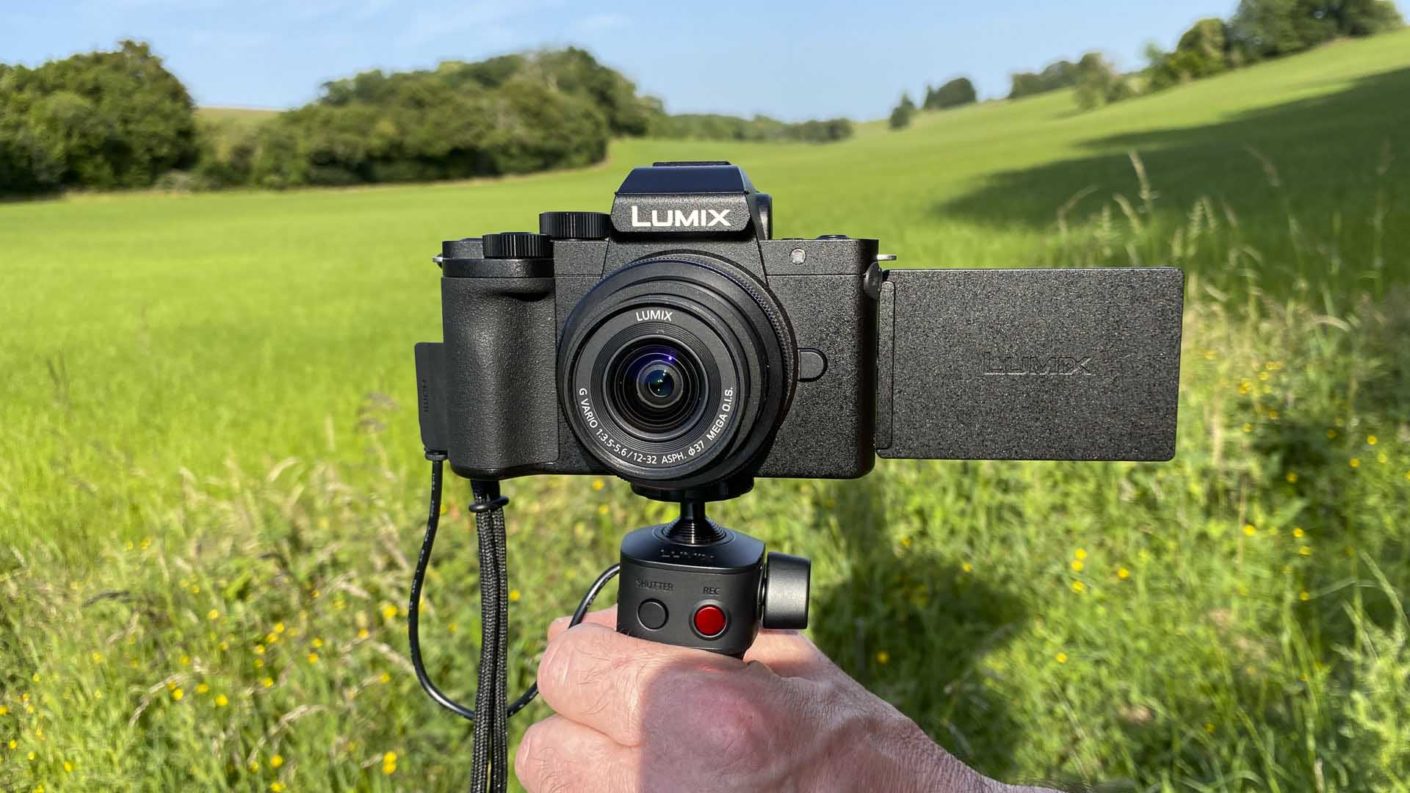
Specification
- Camera type: Mirrorless
- Announced: 24th June 2020
- Sensor: 20.3Mp Four Thirds type CMOS
- Lens mount: Micro Four Thirds
- Screen: 3-inch 1,840,000-dot vari-angle touchscreen
- Viewfinder: 3,480,000-dot electronic viewfinder
- Key video specifications: 4K (3840x2160) at 24,25,30p and 100Mbps, V-Log L and Ozo Audio by Nokia
- Weight: 310g body only, 352g with SD card and battery, 412g with the 12-32mm lens
- Dimensions (WxHxD): 115.6x82.5x54.2mm
Panasonic’s GH series of mirrorless cameras, like the Lumix GH5, have a good reputation amongst videographers and filmmakers. The G100 is designed as an entry-level video camera that’s also a capable stills-shooter.
Although it has a 3.5mm mic port, one of the key selling features of the G100 is the Ozo Audio technology that’s built in. This can be set to operate in different directions and in Tracking mode it works with the face detection system to follow the subject in the frame and keep the audio consistent. It works very well.
There’s also a good quality electronic viewfinder built-in along with a 3-inch vari-angle touchscreen.
£590
$747.99For
- Very compact
- Viewfinder and vari-angle touchscreen
- Clever Ozo Audio by Nokia onboard
Against
- Crop in 4K mode
Sony ZV-1
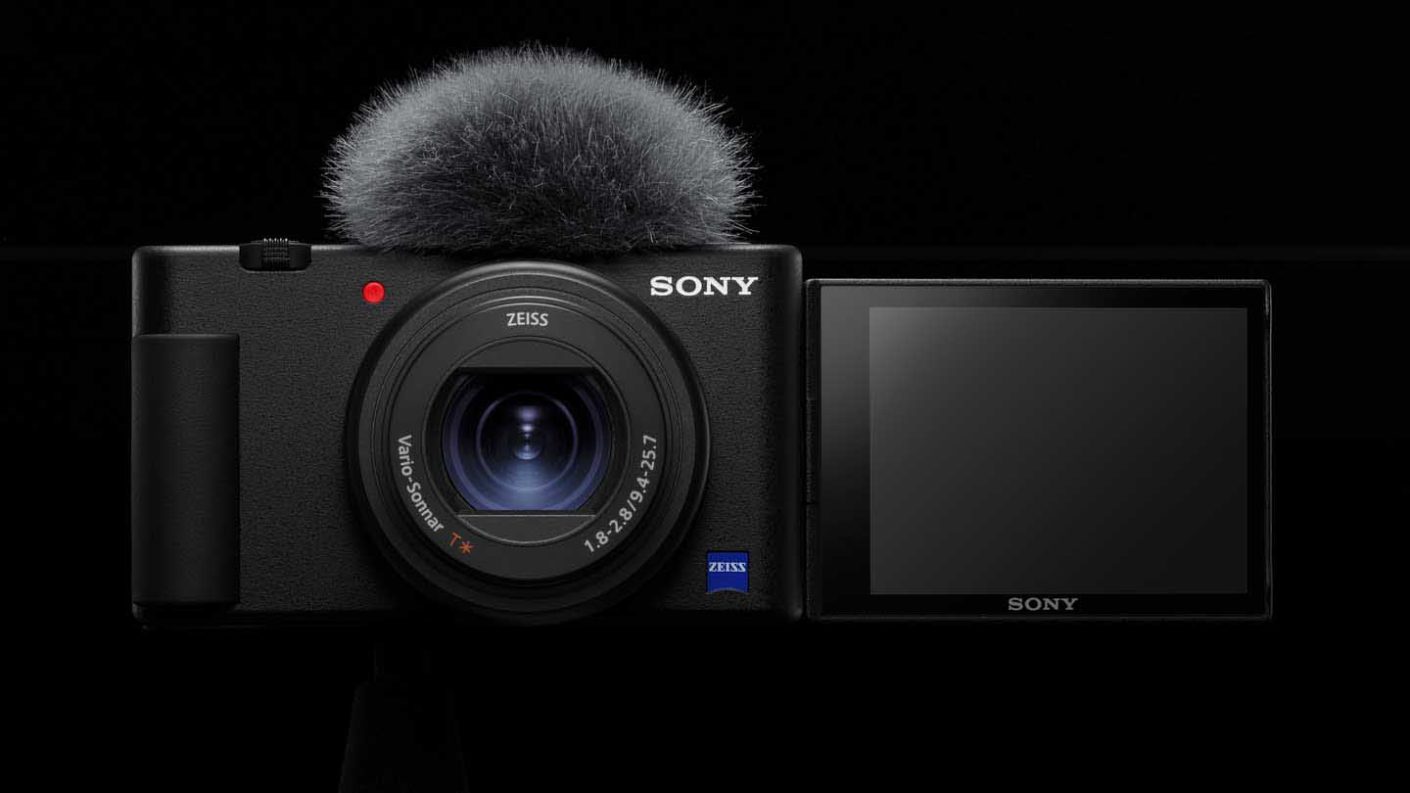
Specification
- Camera type: Compact
- Announced: 26th May 2020
- Sensor: 20.1Mp 1-inch type (13.2mm x 8.8mm) Exmor RS CMOS
- Lens: Zeiss Vario-Sonnar T* 9.4-25.7mmm (24-70mm equivalent) f/1.8-2.8
- Sensitivity range: Stills: ISO 100-25,600, Video: ISO 125-12,800
- Autofocus: 315 focal-plane phase-detection AF points, Eye AF: Humans (stills and video) or Animal (stills)
- Burst Mode: Hi: 24fps, Mid: 10fps, Low: 3fps
- Video: 4K in-body movie recording with full pixel readout and no binning, Log & Gamma options, slow-mo at up to 1000fps
- Viewfinder: No
- Screen: Vari-angle 3-inch touchscreen
- Stabilisation: Optical for stills, optical and electronic for video
- Hotshoe: Multi-interface (can connect an XLR mic via an adapter)
- Storage: SD/SDHC/SDXC
- Dimensions (WxHxD): 105.5 x 60 x 43.5mm / 4 1/4 × 2 3/8 × 1 3/4inches
- Weight: 294g with battery and SD card or body only
The Sony ZV-1 is specifically designed with vlogging in mind. In a first for Sony, it has a vari-angle touchscreen that can be seen from in-front of the camera. There’s also an excellent mic built-in which can be covered by a bespoke windshield that comes in the box and can be slipped in to the camera’s hotshoe. There’s also a 3.5mm mic port if you want to use an external mic and with the right adapter, you can even connect an XLR mic via the hotshoe.
Its autofocus system is also excellent and the Eye AF and Product Showcase are especially useful for vlogging. Plus, Background Defocus and the Face Exposure Priority system help inexperienced videographers get the results they want.
Experienced vloggers will love the compact size of the ZV-1 as well as its high level of control along with the ability to shoot in S-Log3.
£700
$749.99For
- Designed specifically for vloggers but also a capable stills camera
- Stabilised 4K video
- Vari-angle touchscreen
Against
- No viewfinder built-in
- The redesigned grip is best for left-handers
Nikon Z50
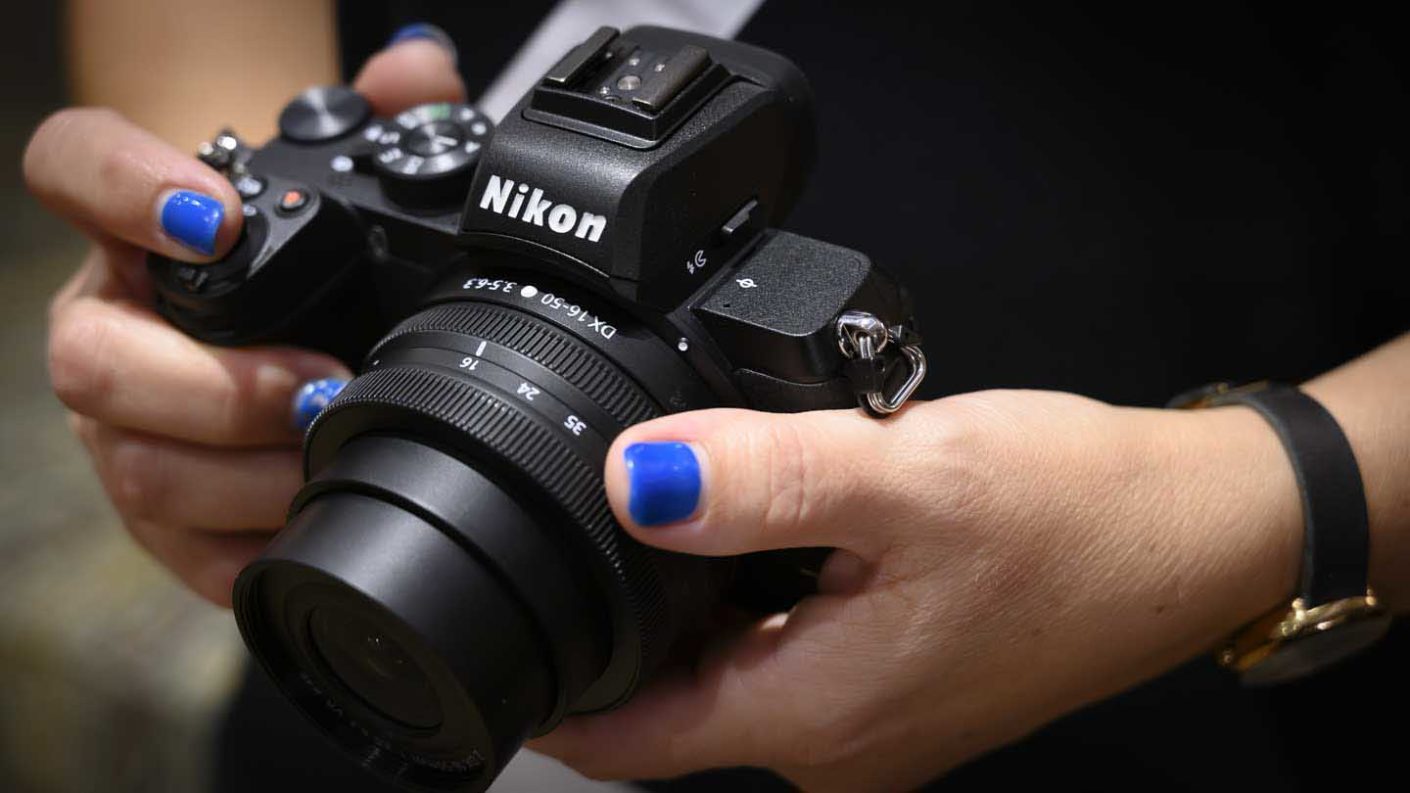
Specification
- Camera type: Mirrorless
- Sensor: 20.88Mp APS-C / DX (23.5x15.7mm) CMOS
- Processing engine: Expeed 6
- Lens mount: Nikon Z mount
- Sensitivity range: ISO 100-51,200; expands to 204,800
- Viewfinder: 0.39-inch 2,360,000-dot OLED electronic viewfinder
- Screen: Tilting 3.2–inch 1,040,000-dot touchscreen
- Autofocus: Hybrid (phase and contrast detection) AF with 209 AF points, Eye AF and Subject Tracking. Firmware V.20 adds Eye-detection AF for Animals as well as humans
- Continuous Shooting: 11fps with continuous AF and exposure metering
- Video: 4K at 30fps and Full-HD at 120fps
- Storage: SD/SDHC/SDXC UHS-I
- Connectivity: Snapbridge 2.6; Wi-Fi, Bluetooth
- Dimensions (W x H x D): 126.5 x 93.5 x 60 mm / 5 x 3.7 x 2.4-inches
- Weight: 450g / 15.9oz with battery and memory card but without body cap, 395g /14oz body only
The Nikon Z50 is a great little 20.88Mp APS-C format camera with a solid build and good feature set. Its control arrangement is also very good, combining buttons and dials with touch-control very well.
On the back of the Nikon Z50 there’s a 3.2–inch 1,040,000-dot touchscreen that can be tilted down to be visible from in front of the camera. It’s fine to have the screen under the camera if you’re hand-holding it, but if you’ve got the camera on a tripod or support, the screen is obscured. The solution is to buy the SmallRig Vlogging Mounting Plate for Nikon Z50 Camera LCN2525 which fits on the bottom of the camera and enables a tripod to be mounted off to the side. This neat unit is supplied as part of the Nikon Z50 Vlogger kit.
£849
$989For
- Superb build and handling
- AF fast and accurate in low light
- Weatherproof
Against
- No joystick
- Can't use the screen to set the AF point while you look in the viewfinder
Canon PowerShot G7 X Mark III
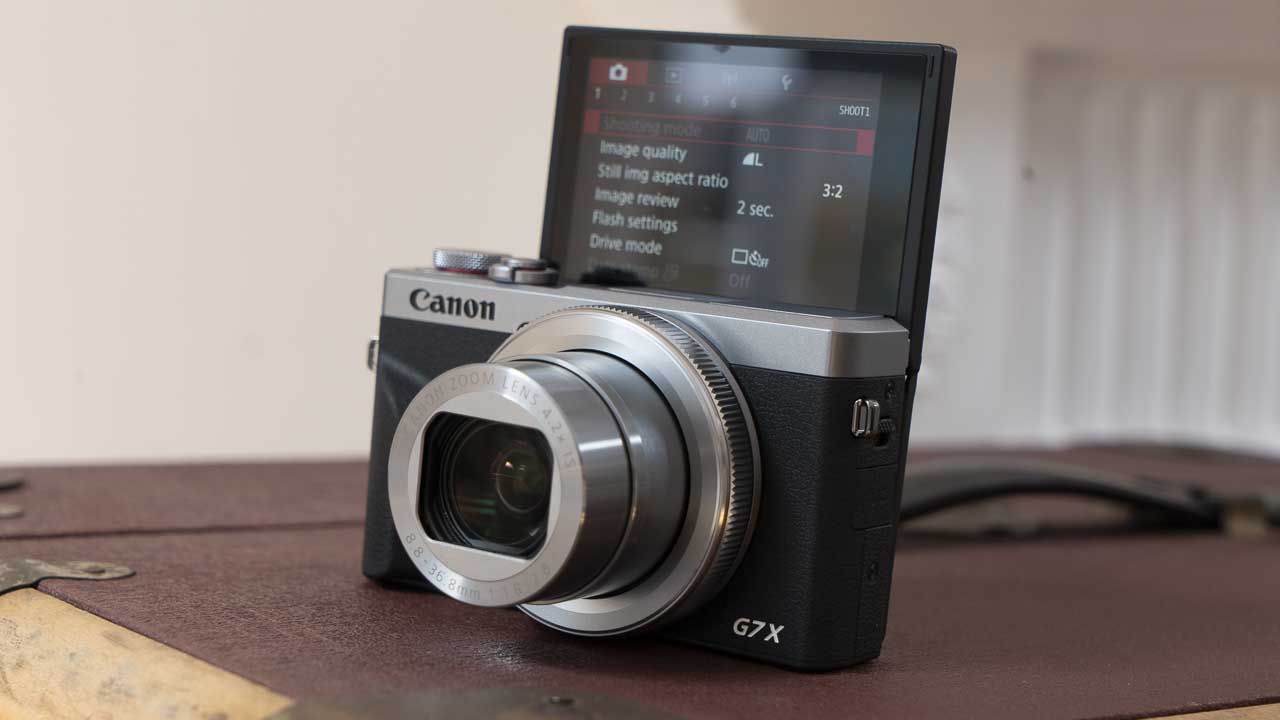
Specification
- Camera type: Compact
- Sensor: 20.1Mp 1-inch type Stacked CMOS
- Lens: 24-100mm (35mm equivalent) f/1.8 – f/2.8
- Viewfinder: 0.39-inch type 2,360,000-dot OLED
- Screen: 3-inch 1,040,000-dot tilting touchscreen
- Autofocus system: AiAF (31-point, Face Detection or Touch AF with Object and Face Select and Track), 1-point AF (any position or fixed centre)
- Sensitivity range: ISO 125-12,800 expandable to ISO 25,600
- Dimensions (W x H x D): 105.5 x 60.9 x 41.4mm
- Weight: 304g with battery and memory card
Canon’s PowerShot G7 X Mark II was a big hit with vloggers but the Mark III has even more to offer. For instance, the PowerShot G7 X Mark III is capable of shooting 4K (3840 x 2160) video at 29.97 / 25fps without cropping. There’s also a 3.5mm mic jack and the HDMI mini port can supply a clean feed to external devices.
Further good news is that Canon has enabled live-streaming to YouTube when the camera is connected to a Wi-Fi network.
It’s also the first camera from Canon to feature a stacked sensor design. Paired with the Digic 8 processing engine, this enables a maximum shooting rate of 30fps.
Like the Mark II, the PowerShot G7 X Mark III has a 24-100mm f/1.8-2.8 lens and a flip-up screen that can be viewed from the front. This makes it an ideal camera for handheld vlogging.
£700
$699.99For
- Live-streaming possible
- No cropping in 4K video mode
- Excellent blend of touch and button/dial control
Against
- No viewfinder
- Would be nice if the ND filter were stronger
Canon EOS M50
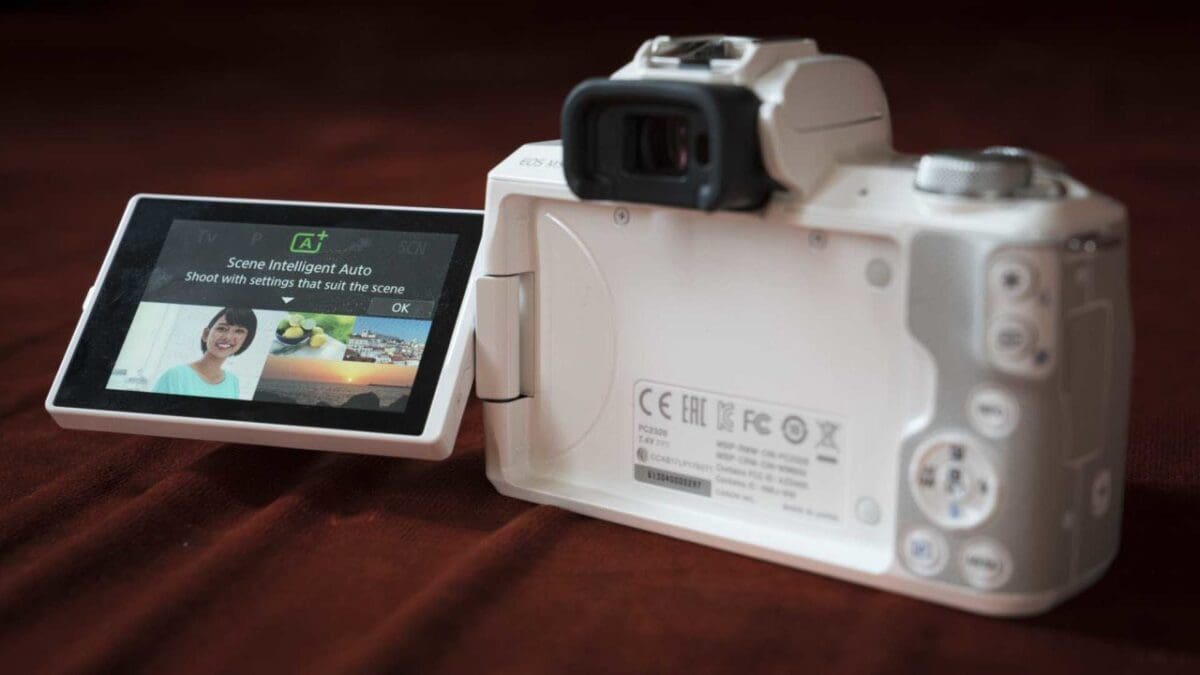
Specification
- Camera type: Mirrorless
- Announced: 26th February 2018
- Sensor: 24.1Mp APS-C format CMOS
- Lens mount: Canon EF-M
- AF system: Dual Pixel CMOS phase detection with up to 143 points
- Viewfinder: 0.39-type 2,360,000-dots OLED EVF
- Screen: Touch-sensitive vari-angle 3.0-inch LCD with 1,040,000 dots
- Max video resolution: 4K (3840 x 2160) at 23.98, 25 fps 10fps
- Max continuous shooting rate: 10fps
- Dimensions (W x H x D): 116.3 x 88.1 x 58.7mm
- Weight: 387g (black), 390g (white) including battery and memory card
To get the bad news out of the way first, although the EOS M50 is 4K-enabled there’s an additional 1.6x crop factor applied to the framing in 4K mode and that’s not ideal for close-quarters filming. Also, the AF system reverts to contrast detection rather than the excellent phase detection system that operates in Full HD video mode.
Now to move on to the good news, the Canon M50 is an excellent camera for vloggers as its APS-C format sensor delivers high-quality video footage, the screen flips out to the side to give a clear view when you’re filming yourself and the AF system does a great job of keeping the focus on the subject. If you’re speaking to camera, you’ll see a reassuring square around your face to let you know you’re in focus.
With the 15-45mm kit lens mounted the M50 sits nicely in your hand and is easy to hold at arm’s length for fairly long periods. It’s also easy to use yet has advanced exposure options if you want to use them. Crucially, there’s also an audio-in port for connecting an external mic.
£540
$680For
- Excellent image quality
- Superb implementation of touch-control
- High-quality viewfinder built-in
Against
- 4K video mode crops the frame
- Plastic feel
- Limited lens range
GoPro Max
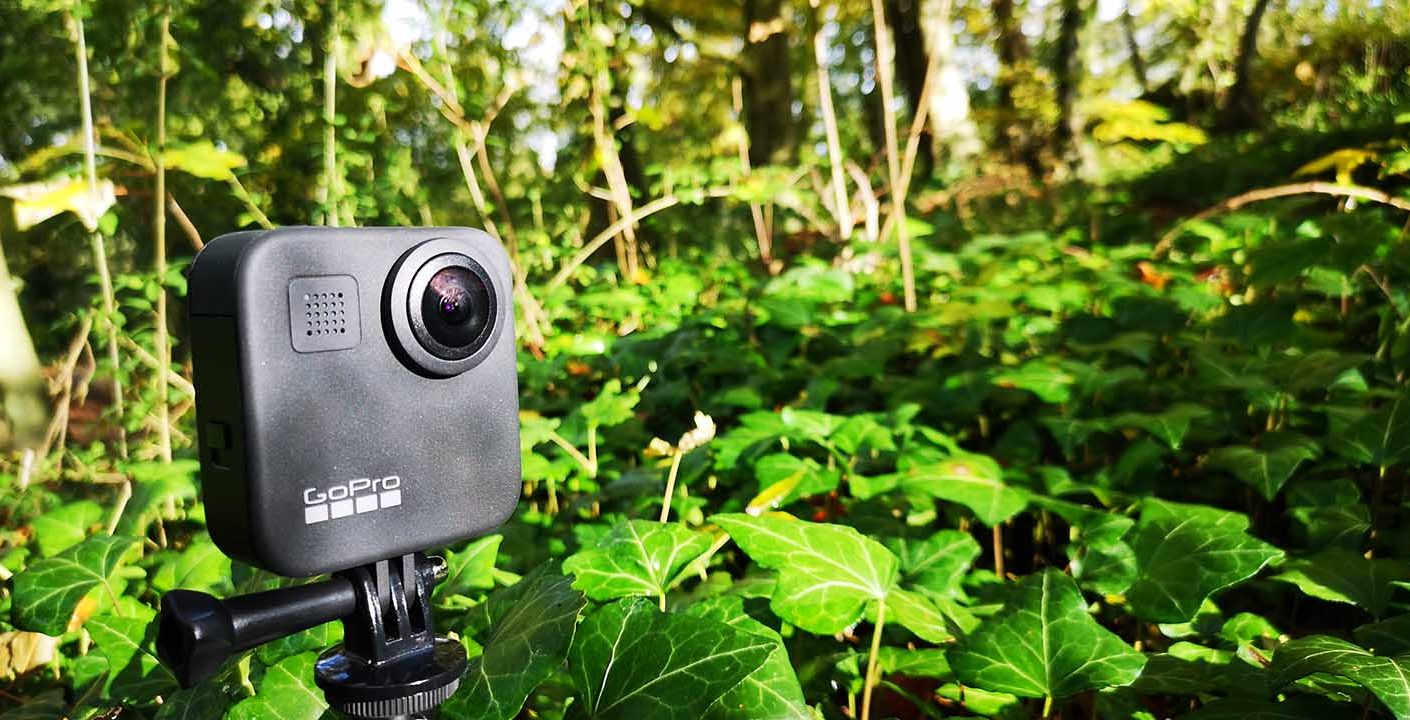
Specification
- Cameras: Dual 18MP Source / 16.6MP Stitched
- Stabilisation: HyperSmooth stabilisation
- Video Resolution: 5.6K at 30fps
Say what, a 360 camera on a list of the best cameras for vlogging? Trust us on this one. We’ve been filming with the GoPro Max since its launch in winter 2019, and we’ve been slowly falling in love with it.
For starters, the Max can shoot 360 video in 5.6K resolution at 30fps. This is actually 6K footage, but it renders at 5.6K after it is stitched in-camera. There’s an excellent Reframe feature, however, that allows you to pick any vantage point within your 360 footage and follow that as a standard-format movie.
You can also swap from 360 to Hero mode where the Max functions as an action camera using just one of its dual lenses – resolution here is limited to 1440p at 60fps or 1080p at 60fps, but the image quality is still superb.
The Max also supports HEVC video format, which produces smaller files while prioritising image quality.
For vloggers, the Max also lets you swap between lenses when filming in Hero mode. This means you can speak to the lens facing you, then swap to the other to show something off-screen. The Max also features six microphones built into its body to capture spherical audio, and you can prioritise audio from one side of the camera. This is very handy when delivering a monologue to the camera.
What’s more, the GoPro Max can livestream Full HD video just like the GoPro Hero8 Black.
£479
$464For
- Shoot full 360º video
- Features HyperSmooth image Stabilisation
- Reframe your video for 1080p or 4K output
Against
- Design still quite cumbersome
- Requires a powerful computer to edit footage
GoPro Hero9 Black
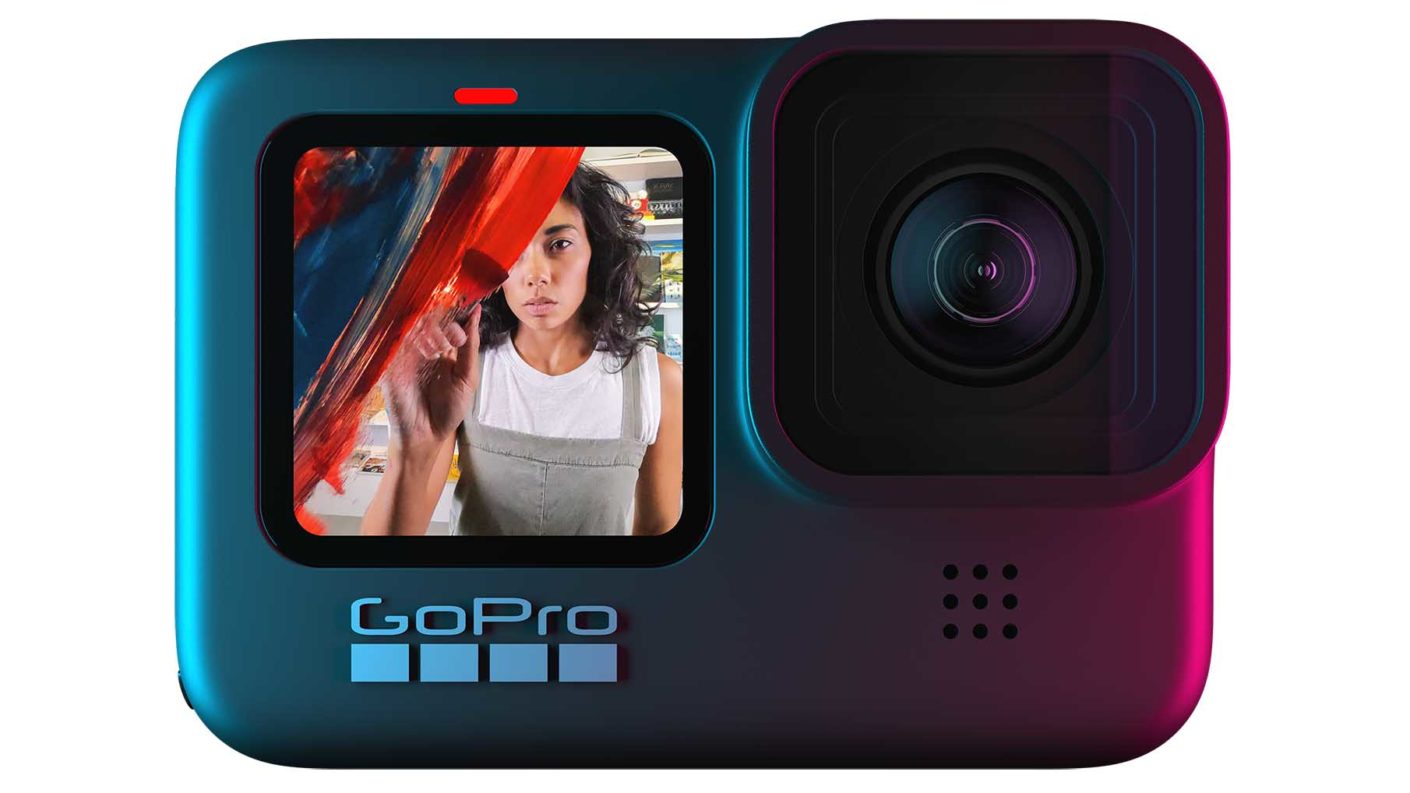
Specification
- Camera type : Action Camera
- Announced: 16th September 2020
- Max video resolution and frame rate: 5k 30p, 4K 60p, 2.7K 120p, 1440 120p, 1080 240p
- Video file formats: MP4 (H.264/AVC), MP4 (H.265/HEVC)
- Max photo resolution: 20mp
- Max bit rates: 100Mbps (2.7K, 4K, 5K)
- Screen: Rear: 2.27-inch touchscreen, Front: 1.4-inch colour screen
- Livestreaming: 1080p
- Voice control: 4 commands in 11 languages + 6 accents
- Battery: Removable, rechargeable 1720mAh lithium-ion
- Storage: MicroSD USH-I
- Connectivity: Wi-Fi, Bluetooth
- Stabilisation: Hypersmooth 3.0
- Waterproof: To 10m / 33 feet
- Dimensions (WxHxD): 71 x 55 x 33.6mm
- Weight: 124g
GoPro’s latest action camera is the best on the market and makes a great all-rounder that gives you the option to record all of your most exciting adventures – whether that’s a simple walk in the park, kayaking down rapids, or carving through the Alps.
There’s a huge range of mounts and accessories, so whatever type of video you want to create, you can do it with it the Hero9 Black. It records in a variety of frame rates, including 5K at 30fps, 4K at 60fps, 2.7K at 120fps and Full-HD at 240fps. There’s also the superb HyperSmooth 3.0 stabilisation system that enables you to capture steady footage in extreme situations – even when mounted on a bike.
Further good news is that the GoPro Hero9 is waterproof without an extra housing, so you can pop it in your bag ready to record your next adventure, whatever that may be.
We found the battery can last for more than a couple of hours, but it’s worth having a spare or two for a full day of adventure.
The GoPro Hero9 produces great footage that you can edit on your computer or you phone, but it can also live-stream if you want to tell everyone what you’re up to straight away.
£330
$349.98For
- No need for waterproof housing
- Dual Screen
- 8X Slow-motion
Against
- Mods are expensive
- Not great in low light
DJI Osmo Pocket
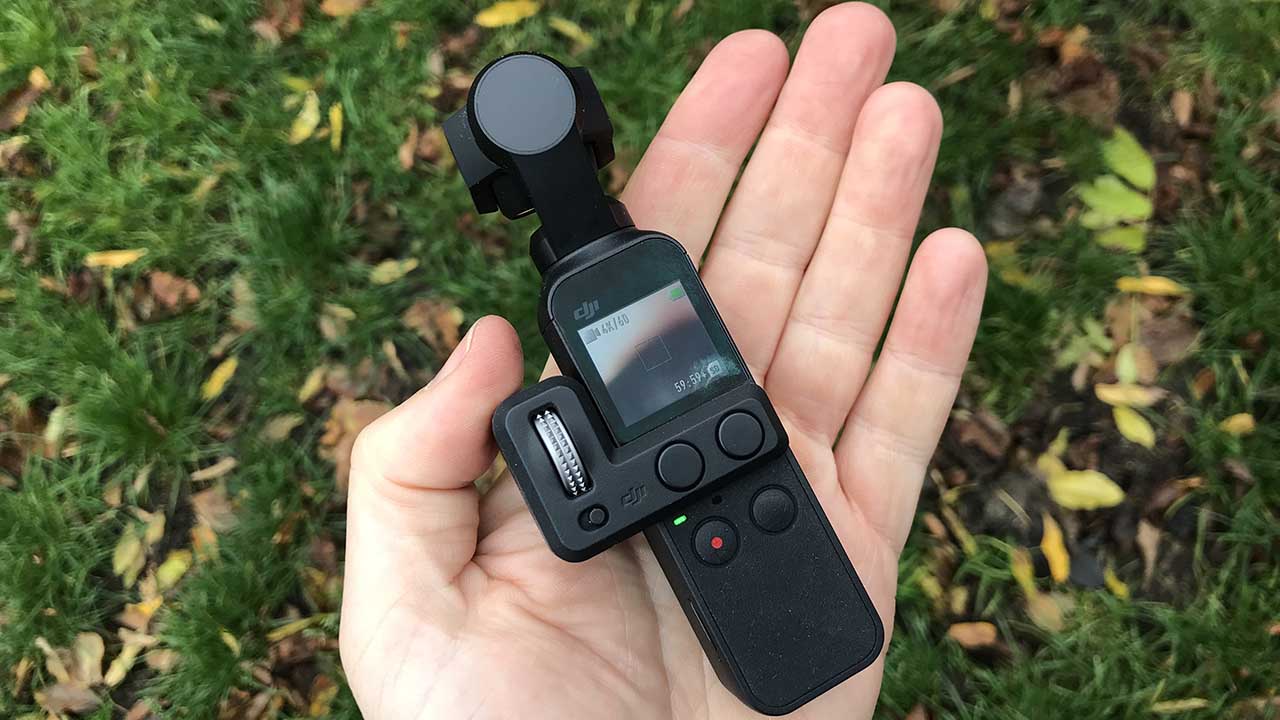
Specification
- Camera type: Stabilised action cam
- Sensor: 12Mp 1/2.3-inch CMOS
- Lens: 26mm (35nn focal length equivalence) f/2.0
- Sensitivity range: ISO 100-3,200
- Stills shooting modes: Single Shot, Panorama, Timelapse, Motionlapse, Hyperlapse
- Video resolution and frame rates: 4K Ultra HD: 3840×2160 24/25/30/48/50/60p, FHD: 1920×1080 24/25/30/48/50/60/120p
- Max Bit rate: 100Mbps
- Dimension: 121.9×36.9×28.6mm
- Weight: 116g
DJI Osmo Pocket, the smallest, lightest and most impressive Osmo to date. It weighs just 116g and measures 121.9 x 36.9 x 28.6mm.
The 12Mp 1/2.3-inch CMOS camera is mounted on a 3-axis mechanical image stabilisation gimbal and it’s capable of capturing 4K video at 60fps. There’s also a series of intelligent shooting modes.
It’s a compact and robust device, and it comes with a Lightning and USB-C adaptor to connect a smartphone. This enables you to view images on a much larger screen than the one built-in to the Pocket. DJI’s free Mimo app also makes editing your video easy.
Movies are captured in MP4/Mov and stills are saved as JPEG, DNG or both. Files are stored on a MicroSD card of up to 256GB capacity.
The audio is decent when the noise reduction is turned off but there’s also a mic adaptor that takes things up a notch.
£329
$399For
- Excellent stabilisation
- High-quality video footage
- Very easy to use and video can be edited on a smartphone using the DJI app or on a computer
Against
- Works best with the Control Wheel
- No live streaming
Canon EOS Rebel SL3 / 250D
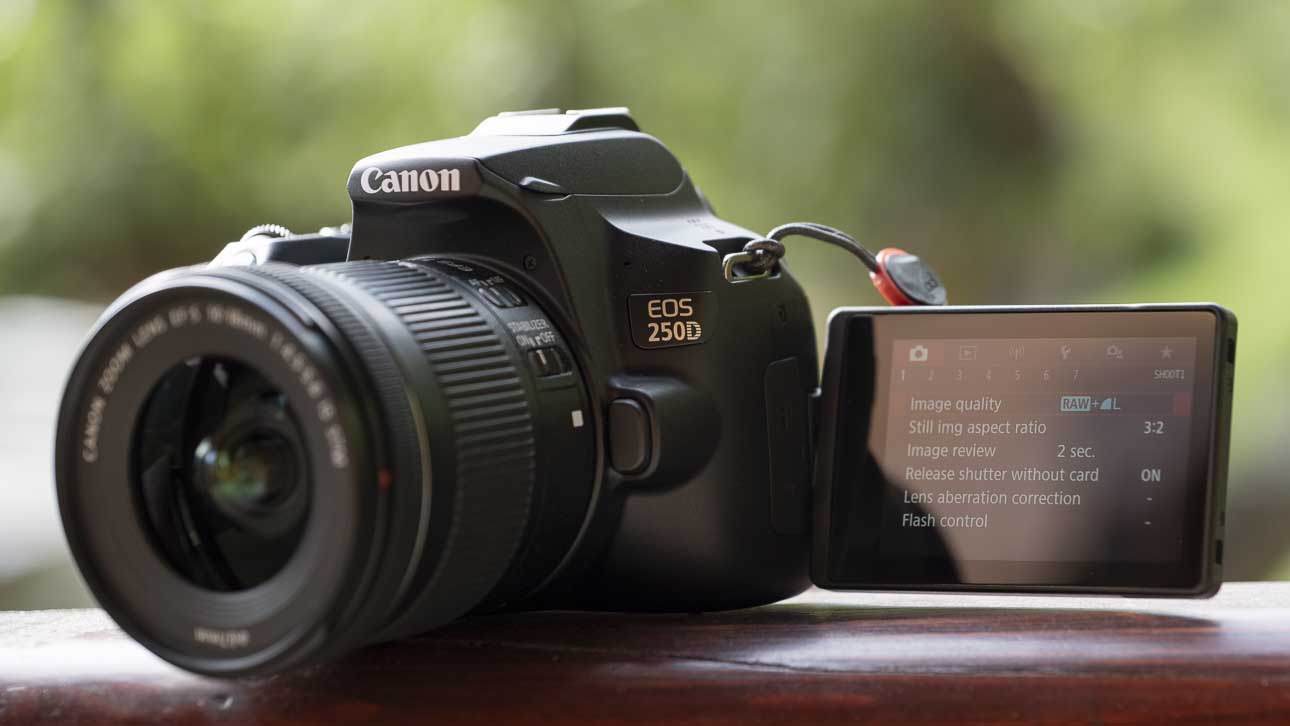
Specification
- Camera type: DSLR
- Announced: 10th April 2019
- Sensor: 24.1Mp APS-C CMOS
- Lens mount: Canon EF-S
- AF System: 9-point phase detection, Dual Pixel CMOS AF (via Live View or Video)
- Viewfinder: Pentamirror 95% coverage optical viewfinder
- Screen: 3-inch vari-angle touchscreen with 1,040,000 dots
- Max video resolution: 4K (3840 x 2160) at 23.98, 25fps
- Dimensions (W x H x D): 122.4 x 92.6 x 69.8mm
- Weight: Black/Silver 449g, White 451g
The world’s lightest DSLR with a fully articulating screen, the Canon EOS 250D (known as the Rebel SL3 in the US) is a good entry into the DSLR market. Videographers will enjoy the articulating screen, while buying into the Canon EOS system means compatibility with a huge range of accessories, including a vast swathe of different lenses.
Although the 250D / SL3 can shoot 4K video, the crop factor increases by an extra 1.5x so the widest point of the 18-55mm kit lens is effectively around 43mm. That’s a bit wide for vlogging at arm’s length, so you may need to add a wide-angle lens to your kit. The focusing also switches from the impressive phase detection system facilitated by the Dual Pixel CMOS AF sensor, to contrast detection which is a little slower. That may mean you want to stick to Full-HD video, but the camera produces great results at both resolutions.
There’s also Wi-Fi and Bluetooth connectivity which means you can connect the 250D to your smartphone to control it remotely and share your videos online.
£530
$599.99For
- APS-C format sensor
- Phase detection autofocus system in video mode
- Vari-angle touchscreen
Against
- Switch between using the viewfinder and screen isn't seamless
- Viewfinder AF system has just 9 AF points
Olympus OM-D E-M5 Mark III
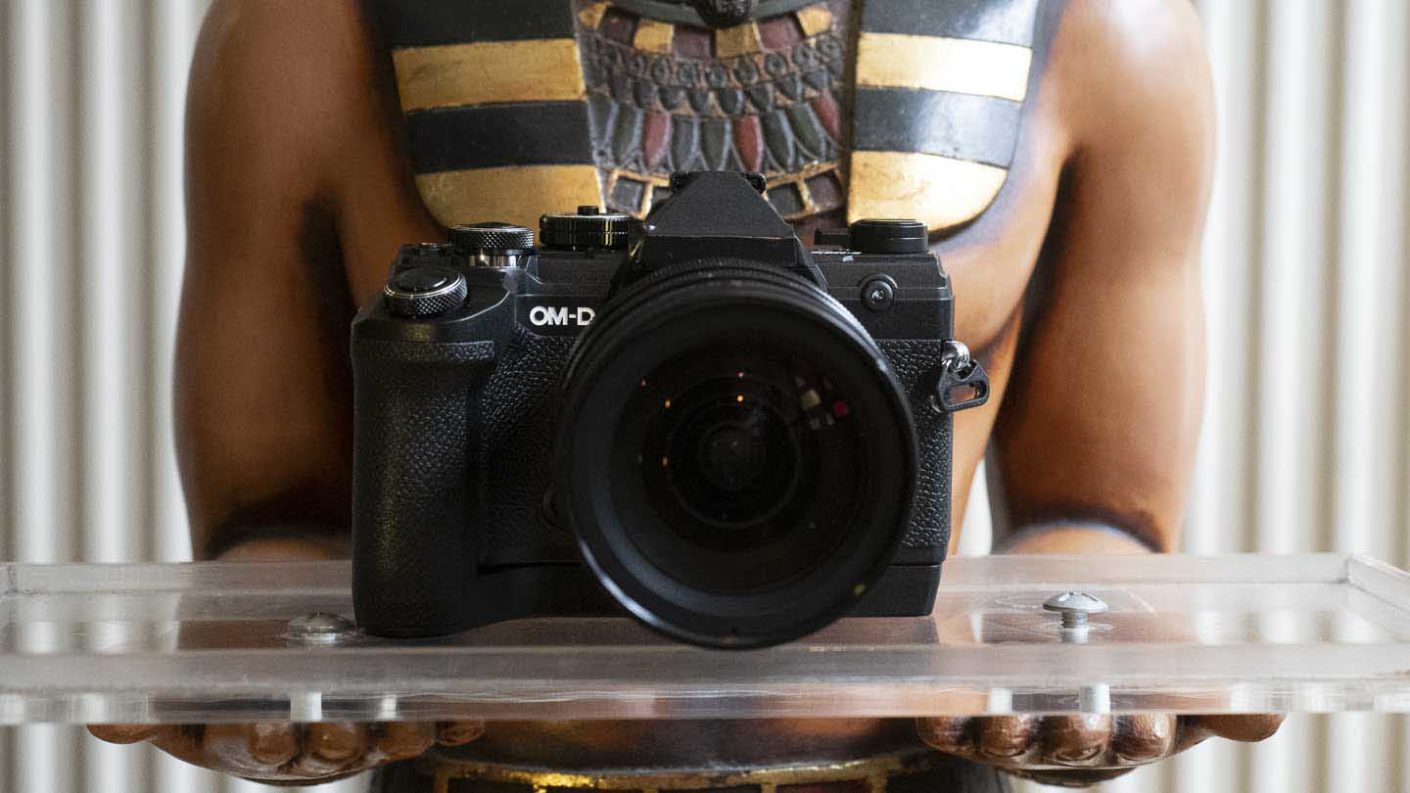
Specification
- Camera type: Mirrorless camera
- Sensor: 20.4Mp Live MOS Micro Four Thirds sensor
- Lens mount: Micro Four Thirds
- Processing engine: TruePic VIII
- Sensitivity range: ISO 64-25,600
- Autofocus system: Hybrid with 121 (all cross-type) phase-detection AF points
- Maximum continuous shooting rate: Mechanical shutter: 10fps with focus and exposure fixed at the start of the burst, 6fps with C-AF, Electronic Shutter 30fps and 10fps
- Max video resolution: C4K 24p at up to 237Mbps / 4K 30p, 25p, 24p at 102Mbps
- Live Bulb Shooting Options: Live Composite, Live Time, Live Bulb, Focus Bracketing, Focus Stacking, 50Mp High Res Shot modes
- Viewfinder: 2,360,000-dot electronic viewfinder
- Screen: Vari‑angle 3.0-inch 1,037,000-dot touchscreen
- Dimensions (W x H x D): 125.3 x 85.2 x 9.7mm
- Weight: 414g including battery and memory card, 366g body only
The Olympus OM-D E-M5 Mark III sits below the OM-D E-M1 Mark III in Olympus’s interchangeable lens camera lineup. It has a smaller body, which makes it a great choice for travel. It also produces nice images and the stabilisation system is incredible, enabling you to hand-hold the camera and get sharp images with exposures measured in whole seconds. In addition, it does a good job with video; although if you’re really serious about shooting moving images you might want to look at the Panasonic Lumix G90 which has a true Log mode.
Olympus has given the E-M5 Mark III the same 20.4Mp Live MOS sensor as the OM-D E-M1 Mark II. The processor is also listed as the same TruePic VIII engine, but Olympus tells us it’s been updated for a bit more oomph.
Like the OM-D E-M1 II, the OM-D E-M5 III has a 121-point (all cross-type) phase-detection autofocus (AF) system. There are also clever shooting options such as Live Composite, Live Time, Live Bulb, Focus Bracketing, Focus Stacking and a 50Mp High Res Shot mode.
As with its predecessor, the OM-D E-M5 II, the High-Res Shot mode is a tripod-only option. When this mode is activated, the E-M5 III shifts the imaging sensor by 0.5-pixel movements between 8 shots. These are then merged into one image that’s equivalent to 50Mp.
Olympus has upgraded the video capability of the OM-D E-M5 Mark III in comparison with the Mark II model. The new camera is capable of shooting C4K 24p video at up to 237Mbps or 4K 30p, 25p, 24p video at 30p 102Mbps.
What’s more, Full-HD video can be shot at up to 120p for slow-motion playback.
Read our buyer’s guide to the best Olympus cameras
£1100
$1199.99For
- Images full of detail
- Low noise at higher ISOs
- Superb stabilisation
Against
- Image quality can't quite match full-frame
- Dynamic range could be better
Panasonic Lumix S5
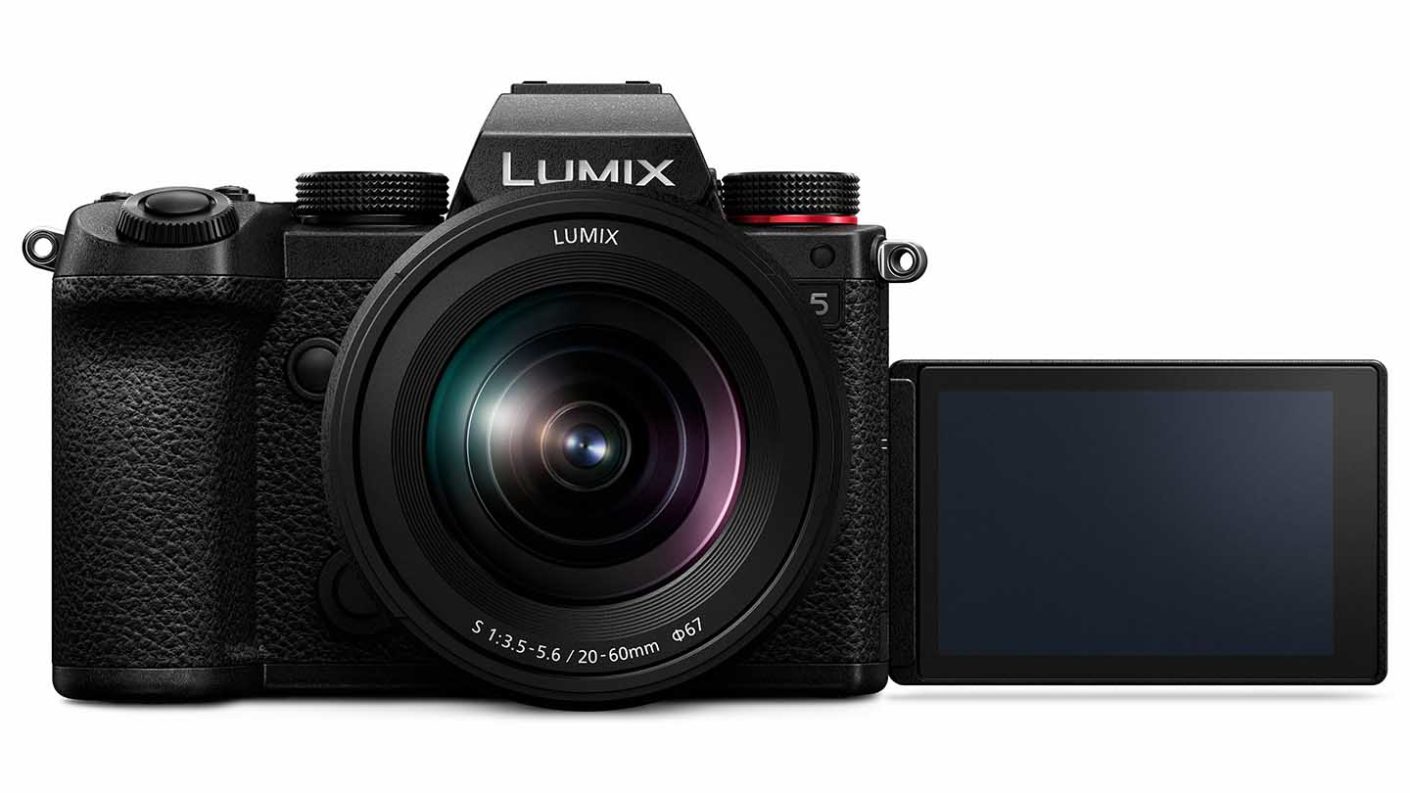
Specification
- Camera type: Mirrorless
- Announced: 2nd September 2020
- Sensor: 24.2Mp full-frame (35.6 x 23.8mm) CMOS sensor
- Lens mount: L
- Construction: Magnesium alloy with dust and splash resistant seals
- Stabilisation: 5 axis in-body IS to 5EV, 6.5 with Dual IS
- Screen: 3-inch 1,840,000-dot vari-angle touchscreen
- Viewfinder: 2,360,000-dot OLED electronic viewfinder with 0.74x magnification
- Key video specifications: 4K (3840x2160) 4:2:2 10-bit LongGOP H.264 29.97/23.98p/25p and 150Mbps for up to 30mins, 4K (3840x2160) 4:2:0 8-bit LongGOP H.264 29.97/23.98p/25p and 100Mbps unlimited, Full HD (1920x1080) 4:2:2 10-bit LongGOP H.264 59.94/29.97/23.98p/50/25p and 100Mbps unlimited
- Slow & Quick motion: Slow: 4K up to 60p in MP4, FHD up to 120p at full width or 180p with narrower angle of view, Quick: 4K to 1p
- Sensitivity: Dual native ISO 100, 6400, Range: ISO100-51,200, expandable to ISO 50-204,800. Dual-native ISO for video
- Shutter speed: 60-1/16,000sec, Bulb to 30mins
- Maximum continuous shooting rate: AF-S or manual focus: 7fps, AF-C: 5fps, 6K Photo 30fps, 4K Photo: 60fps
- Memory: Dual SD card slots, 1 UHS-II, 1 UHS-I
- Weight: 714g with memory card and battery
- Dimensions (WxHxD): 132.6x97.1x81.9mm
Panasonic decided to address some of the criticisms of its S1-series of full-frame mirrorless cameras with the S5 and made it significantly smaller and more affordable. In fact, the Panasonic S5 is smaller than the Micro Four Thirds Panasonic GH5.
Panasonic also completely reworked the S5’s autofocus algorithm to make it more responsive. That work paid off, making the S5 a good choice for general photography and videography, but it’s not quite as snappy as the phase-detection AF systems in cameras like the Canon EOS R6 and Sony A7 III.
The S5 is aimed at people who have started out as photographers and content creators and who want to create more video. Its headline video specification is that it can shoot 4K (3840×2160) footage in 4:2:2 and 10-bit LongGOP H.264 at 29.97/23.98p/25p. That’s when recording internally to an SD-type card.
It can shoot at that quality and resolution for up to 30 minutes, but if you drop to 4:2:0 8-bit 4K footage, it can record indefinitely until the memory cards are full.
In summary, the Panasonic Lumix S5 is a very nice all-rounder that captures attractive stills and video.
£1799
$1998For
- Smaller than the MFT Lumix GH5
- Viewfinder and vari-angle touchscreen
- V-log pre-installed
Against
- Contrast-detection AF doesn't match the phase-detection competition
- On-screen icons are quite small
Fujifilm X-S10
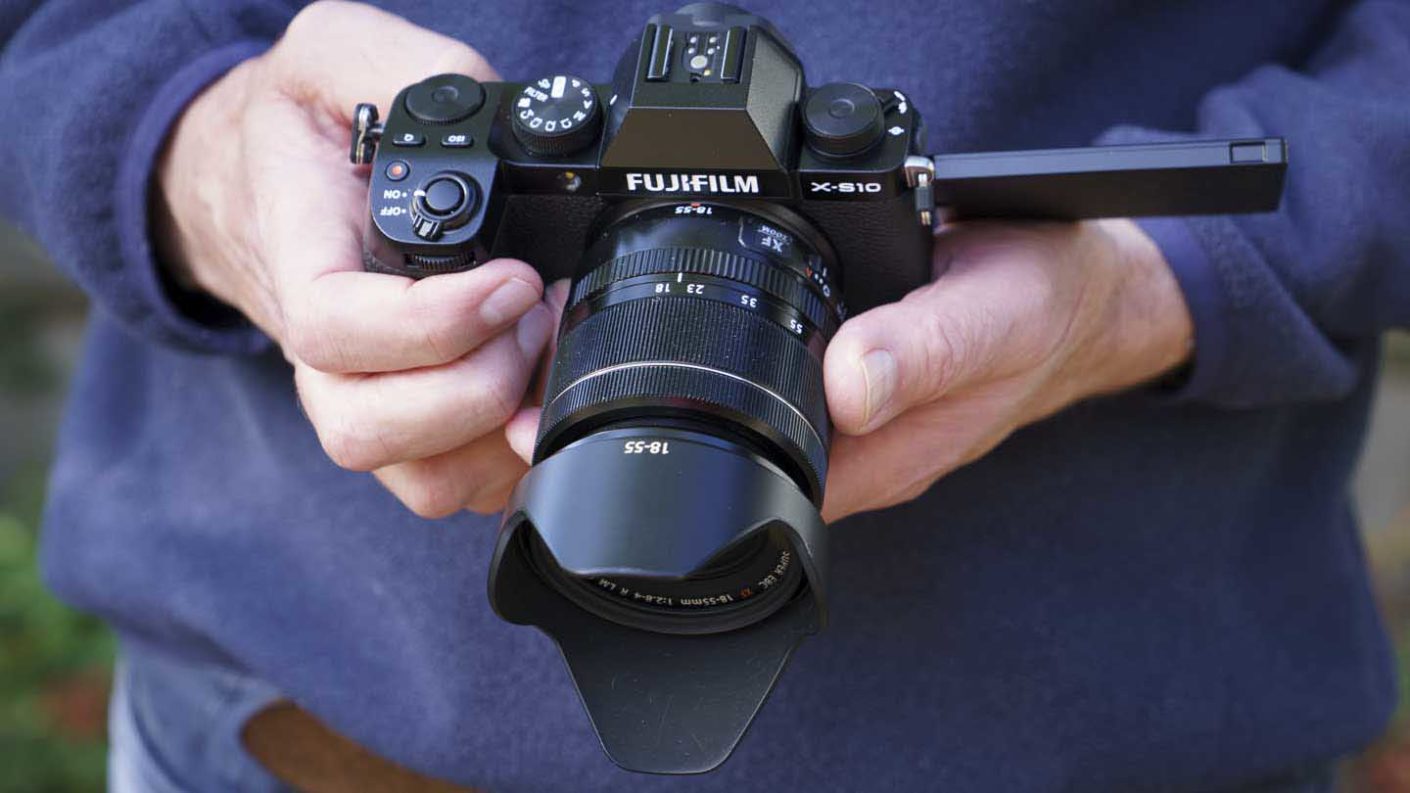
Specification
- Camera type: Mirrorless
- Announced: 15th October 2020
- Sensor: 26.1MP X-Trans CMOS 4 APS-C sensor
- Processing engine: X-Processor 4
- Lens mount: X-Mount
- Sensitivity range: ISO 160-12,800 expandable to ISO 80-51200
- Viewfinder: 2.36-million-dot EVF (100% coverage) with 0.62x magnification
- Screen: Vari-angle 3-inch 1.04million-dot touchscreen LCD
- Autofocus system: Intelligent hybrid with up to 425 selectable AF points
- Continuous shooting: Mechanical Shutter: 8fps, Electronic Shutter: 20fps continuous shooting at full resolution with AF
- Max video resolution: DCI 4K (4096 x 2160) at 29.97/25/24/23.98fps, 4K/30p 4:2:0 8-bit, 4K/30p 4:2:2 10-bit video via the HDMI, Full-HD at up to 240p
- Storage: SD/SDHC/SDXC UHS-II
- Dimensions (WxHxD): 126.0x85.1x65.4mm
- Weight: 465g including battery and card
The Fujifilm X-S10 is the first in a new line of X-series cameras from Fujifilm. It’s aimed at experienced DSLR users who are looking to switch to a mirrorless camera but who don’t fancy the traditional exposure controls of models like the Fujifilm X-T4 and X-T3.
Consequently, the X-S10 has an exposure mode dial on its top-plate and although it’s compatible with Fujifilm lenses with an aperture ring, it has dual control dials to adjust exposure via the camera.
Inside the X-S10 there’s the same 26.1Mp APS-C format X-Trans CMOS 4 sensor as X-Processor 4 as is in the Fujifilm X-T4, which means it can capture the same quality images. It also means that the X-S10 has 425 individually selectable AF points available for use with its hybrid autofocus system – and it’s a snappy performer.
The X-S10 has in-body image stabilisation (IBIS) on board and it can deliver up to 6EV shutter speed compensation.
Naturally, Fujifilm’s Film Simulations modes are available for use, in fact, there are 18 on the X-S10, so you should always find an image style to suit your mood and the subject.
Further good news about the X-S10 is that its touchscreen is mounted on a vari-angle hinge, which makes it ideal for vlogging and shooting selfies. It can also shoot good-quality uncropped DCI 4K video (4096 x 2160) at 29.97/25/24/23.98fps. Internal recording maxes out at 8-bit 4:2:,0 but if there’s an external storage unit connected via HDMI it’s possible to record in 4:2:2 10-bit. A 3.5mm microphone port is built in and a USB-C adapter is included in the box to connect headphones.
You can find the Fujifilm X-S10 on Amazon UK and Amazon USA
£949
$999For
- In-body image stabilisation
- Vari-angle touchscreen
- Excellent sensor and processor combination
Against
- Not weather-sealed
- Complex collection of continuous shooting options




Hero9 is my No.1 pick. Action cameras are simply more versatile and that’s why I always choose them for vlogging.